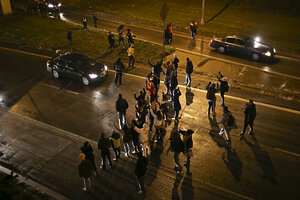Jamar Clark shooting: Why Minneapolis investigators won't release videos
Jamar Clark's death sparked protests in Minneapolis, including in which hundreds of people blocked I-94 Monday night, leading to 42 arrests.

Marchers stop traffic on an entrance ramp to westbound Interstate 94 before moving to the main freeway Monday, Nov. 16, 2015, in Minneapolis. The mayor of Minneapolis on Monday asked for a federal civil rights investigation into the weekend shooting of a black man by a police officer during an apparent struggle. Community members and activists called for a federal investigation, as well as for authorities to release video of the incident and the officer's identity.
(Jeff Wheeler/Star Tribune via AP)
Minneapolis
State investigators looking into the fatal shooting of a black Minneapolis man by police during a scuffle have several partial videos of the incident but won't release them at this time, despite demands from protesters, an official said Tuesday.
Jamar ONeal Clark, 24, died Monday evening, a day after he was shot by police during an early morning dispute, the state Bureau of Criminal Apprehension said Tuesday.
Some witnesses said Clark was handcuffed when he was shot. Police initially said he was not handcuffed, but authorities later said handcuffs were at the scene and they were trying to determine whether Clark was restrained. His death sparked protests including one Monday night in which hundreds of people blocked traffic on an interstate highway, leading to 42 arrests.
The BCA is investigating the case, and federal agencies agreed Tuesday night to Mayor Betsy Hodges' request for a civil rights investigation. That satisfied one of the protesters' demands, but investigators haven't met two others: the release of any video and the identities of the officers involved.
The federal investigation will be conducted by the FBI and will be concurrent to the BCA's probe. In a statement, federal authorities asked for cooperation from any witnesses and urged calm during the investigation.
As The Christian Science Monitor reports protester's requests are not unusual, and in fact, in a post-Ferguson era, police departments in some cities are trying a more proactive approach, including voluntarily releasing video when it supports their innocence, and even securing independent investigations of their own departments, to quell community anger and regain trust.
"When there's a video that backs up what they say, I think that's an enhancement of the public trust," Iowa City Police Chief Sam Harga told the Associated Press recently. Officers in his department have recently started wearing body cameras.
Minneapolis police said the incident began when they were called to north Minneapolis around 12:45 a.m. Sunday following a report of an assault. When they arrived, a man was interfering with paramedics helping the victim, police said. Officers tried to calm him, but there was a struggle. At some point, an officer fired at least once, hitting the man, police said.
BCA Superintendent Drew Evans said at a news conference Tuesday that investigators have video from several sources, including an ambulance, a mobile police camera stationed in the area, public housing cameras and citizens' cellphones.
But he said none of the videos captured the entire incident and none will be released while the investigation is ongoing to avoid possibly tainting it.
Authorities have said the officers involved weren't wearing body cameras. Evans said there is no police dashcam video of the shooting. He declined to release any identifying information about the officers, including their race, pending interviews with them.
When asked if the video shows whether Clark was handcuffed, Department of Public Safety spokesman Bruce Gordon reiterated that the video captures a portion of the incident, but not everything, and said officials can't discuss specifics because it could potentially taint witness statements.
Evans said at the news conference that there were handcuffs at the scene and authorities were still investigating.
"We're still examining whether or not they were on Mr. Clark or whether or not they were just (fallen) at the scene. That's what we're trying to ascertain," he said.
Evans also confirmed that Clark was unarmed. Pressed on the timeline for results of the BCA investigation, Evans said two to four months is typical but that the Clark case "has been given top priority."
The Hennepin County Medical Examiner's Office ruled Tuesday that Clark died from a gunshot wound to the head. Clark's father previously told The Associated Press that his son suffered a single gunshot wound over his left eye.
Clark's brother, Jamine Robinson, 32, of Rochester, told the AP earlier Tuesday that family members had gone to the hospital Monday evening to take Clark off life support. He said he didn't go because he didn't want to see his brother in a hospital bed.
"I want the officer to be arrested, prosecuted and put in jail for eternity. Life without parole," said Robinson.
In seeking the civil rights investigation on Monday, Hodges said she was concerned about "transparency and community confidence." She expressed faith in the state investigation but said the city needs "all the tools we have available to us."
Protesters have set up tents around the 4th Precinct station near where the shooting occurred and said they won't leave until authorities release the video and officers' identities.
The protests are just the latest expression of tension between the department and minorities in the city.
The rocky relations have led to discussions between police and minorities and the creation of task forces designed to quell concerns. This spring, Minneapolis was selected for a federal Justice Department program to rebuild trust between police and the communities they patrol.

